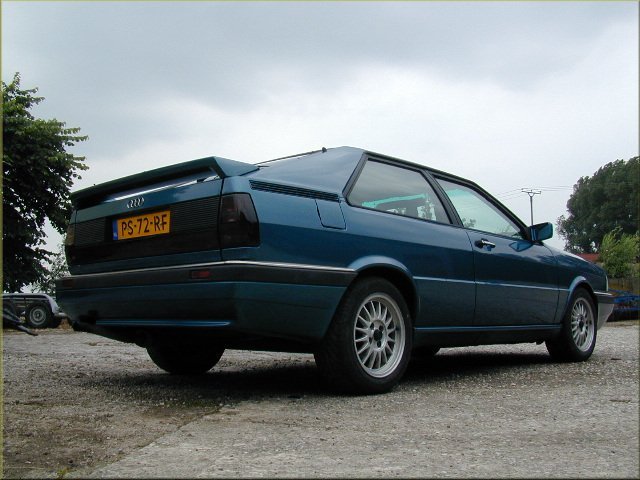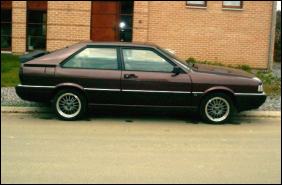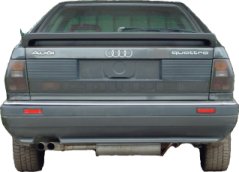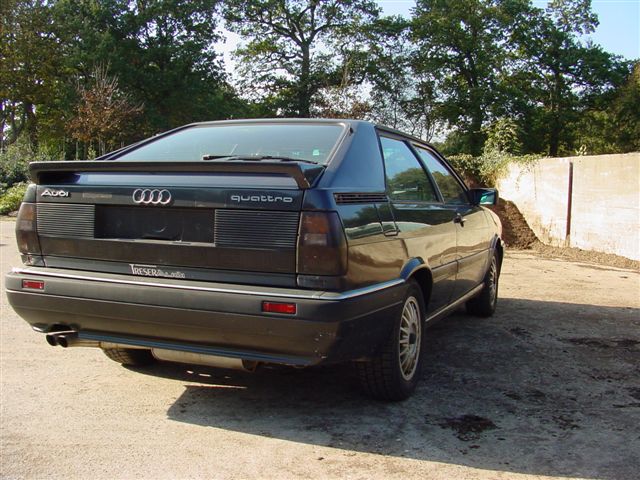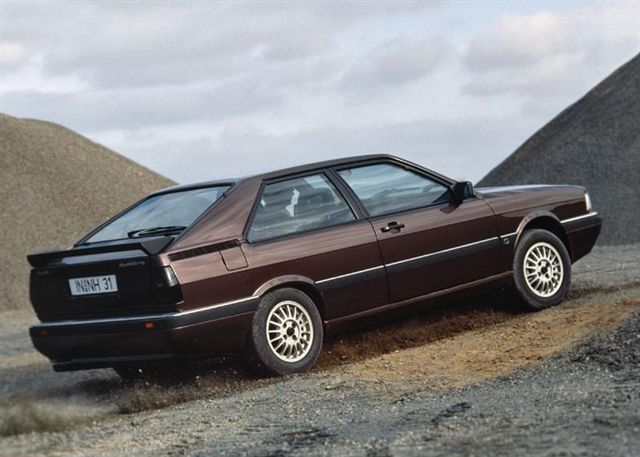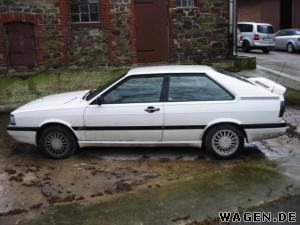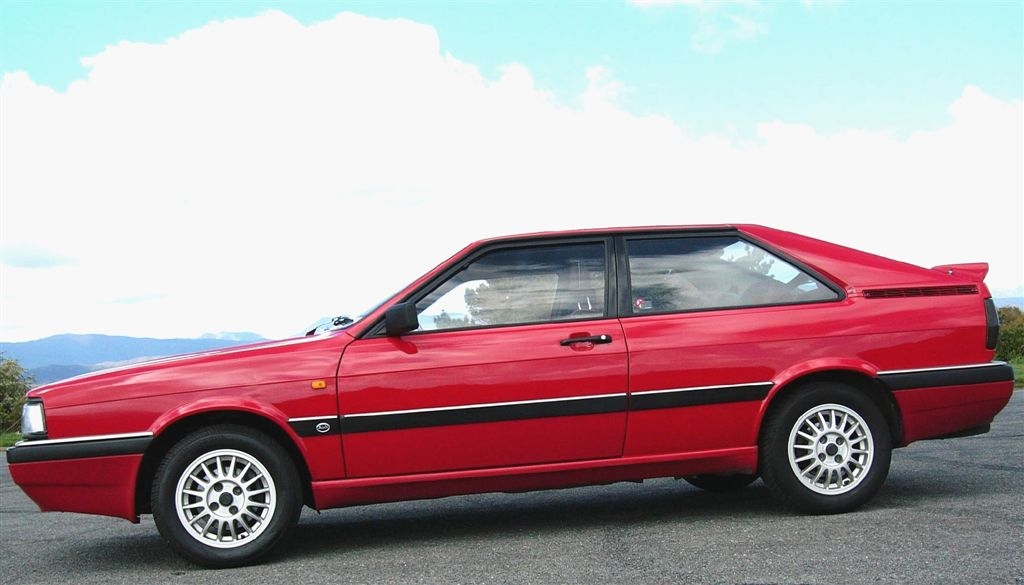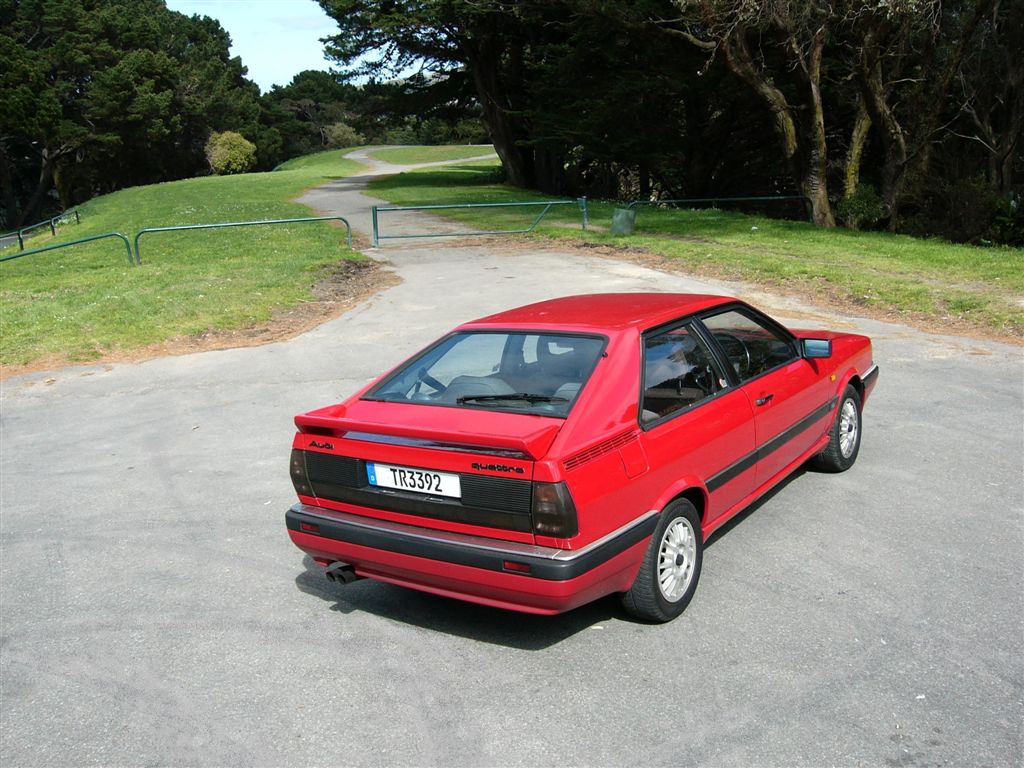The Coupe quattro
My CQ
Ongoing Restoration
Gallery
Info / Data
Suppliers
Links
T85q.com
Project Coupe quattro
By Michael Brown
The Type 85 Coupe quattro (1984-88) and 90 quattro (1984-86) have long been bargains for those wishing to run a four-wheel-drive Audi at a reasonable cost. replica watches They are charismatic, durable and reliable cars, which recall the glory days of the 1980s rally era. The 90 and Coupe quattro, while less prominent than the turbocharged Coupe, also gained many accolades during their competition careers.For these reasons, I resolved to purchase a good Type 85 Coupe quattro and upgrade it to bring it close to Ur-quattro handling characteristics. replica watches uk Having owned an Ur-quattro and Coupe quattro some years before, I had enjoyed the un-temperamental nature and substantially lower running costs of the normally-aspirated car, but having experienced the firmer, flatter, more precise suspension set-up of the Ur-quattro, I was convinced there were improvements to be made. I wanted to end up with a straight, clean car looking close to standard externally, but benefiting from some improvements under the skin.
I found a car in early 2002 before I’d even started looking in earnest. It was in excellent condition with a good history, and the owner was selling it for the best of reasons – to purchase an Ur-quattro. replica watches uk A 1987 Coupe quattro with 107,000 miles on the clock, the car had other features I liked; it was without the marginally useful tilt-or-remove sunroof used on most Coupes of this era (no sunroof drain tubes to get blocked and cause rust, and a lighter and more rigid shell as well as more headroom), and the specification included the rather more useful 3-channel Bosch ABS – an expensive option when new. Finished in attractive Tornado red, the car was otherwise standard with a brown “Brazil” cloth interior. The bodywork was in excellent condition, apart from colour variations on the driver’s side; the result of a replacement door skin.
The previous owner said that the car had been imported into New Zealand from Japan in October 1995, but no other details were available. I thought this unusual given the miles-calibrated instrumentation, as both Japan and New Zealand use metric instruments and right-hand drive. The mystery was solved later after some research when I discovered the car was first registered on 20th January 1987 as D184 GHV by Alan Day Ltd, Regent’s Park Rd, London by a Japanese journalist working in the UK. cartier replica He took the car back to Japan with him in October 1987, and sold the car only a few months before it arrived in New Zealand, which means I was able to confirm the mileage and the fact that I am only the fourth owner since new.
The first step was cosmetic tidying. I was careful not to purchase a car needing major bodywork repairs – fixing it properly would be uneconomic. While not galvanised, the Type 85 is very rust resistant unless the paint has been damaged in some way, there is improperly repaired crash damage, or through sustained neglect. hublot replica uk After 15 years I didn’t expect perfection - there was a little rust under the windscreen rubber, the oddly coloured right side and tatty-looking side mouldings to deal with. Once the windscreen was out, some minor surface rust along the bottom of the windscreen aperture was revealed – a known weak spot on the Type 85. Only five of the six side mouldings were still available, so an extra passenger door moulding was purchased and shortened to fit the right rear guard. The sun-damaged threadbare interior was remedied by sourcing another one from the UK and making a good interior from the two. Worn, faded or broken interior trim was replaced with parts from a dealer and a scrap yard. The Tornado Red paintwork requires regular use of high-quality wax to keep it in top condition, but the result justifies the effort.
Finally the upgrades could start. I have been told that the Ur-quattro chassis (with its gussets, thicker sills and extra welds) is more rigid than the standard Coupe shell. I thought a strut brace would improve chassis rigidity and bring it closer to the feel of the Ur-quattro chassis. After examination of photographs in magazines I concluded that the factory strut brace used in the later 80 V6, S2, RS2 and Cabriolet would fit, as the floorpan and strut towers of the later cars are very similar to those of the earlier ones. The factory strut brace brackets were fitted, and a high tensile alloy cross-bar was fabricated instead of the expensive, heavy steel factory bar with its slotted bolt holes. Battery removal requires unbolting the cross-bar as it does on the early S2 – easily accomplished with a 6mm Allen key. A subtle though definite improvement in body rigidity was the result.
With the far-from-perfect state of New Zealand’s roads, I wanted a suspension set-up like that of the Ur-quattro; firm, yet still compliant with little roll. The standard springs are certainly stiff enough for use on the road, though test reports even when these cars were new commented on the Coupe quattro’s soft dampers. As with Audi Driver’s Project quattro, and for the same reasons, I settled on Koni Sport adjustable dampers set to 50% (half way between the softest setting and the firmest setting). For further increased durability and handling precision I incorporated Ur-quattro blue strut top mounts, and Super Flex polyurethane wishbone bushes and sub-frame mounts. The difference is marked; initial turn-in is now very sharp and steering feel is vastly improved. Body roll on corners and pitching under acceleration and braking are largely eliminated, and the car feels sportier, lighter and more nimble – actually as though it could do with another 150PS!
The new, firmer dampers mean the (standard) brakes act more quickly on application due to the lack of weight transfer, resulting in shorter stopping distances. Although the polyurethane bushes do increase road noise slightly, it is barely noticeable. As the standard springs are retained, the set-up remains compliant, and it copes well with a variety of road surfaces.
The ‘KV’ 136PS 2226cc 5-cylinder engine is torquey and fabulous-sounding and, due to its high compression, in some increments in the higher gears it generates more torque than the 1980-87 turbo ‘WR’ 200PS engine. As the car at 1200kg is a lightweight compared to many modern vehicles, 136PS gives performance on the better side of adequate, and the engine remains surprisingly economical, rising to over 30mpg on the open road. While the car won’t win any drag races, it will certainly keep up with more powerful machinery on the open road – especially in the twisty bits. Overtaking performance is surprisingly good, as the torque peaks at 186Nm at 3500rpm – right where it is needed. However, in standard form the engine doesn’t feel very happy above 4000rpm. After installation of a K&N air filter and the replacement of the convoluted air intake trunking with a piece of 3” plastic pipe directly to the airbox from behind the right headlight, breathing is much improved. Apart from cleaning or replacement of various breather hoses, and replacement of the engine mounts, nothing else has been done to the engine; now at 131,000 miles it is in excellent health and uses no oil. I use genuine oil filters and Castrol Formula R 10w60 synthetic oil.
On purchase the car had a UK dealer-fitted Diavia air conditioning system. Upon seeing a fractured hose I realised that fixing the system, including the legally-mandated upgrade to CFC-free R134a refrigerant, was going to be costly. So I took a leaf out of Lotus founder Colin Chapman’s book, who said “for more speed, add lightness” and removed the air conditioning system entirely. The result was 40kg off the front axle – a not inconsiderable amount. No visible trace remains – even the AC switch (next to the ABS switch) was replaced with a factory blanking piece.
The stereo came in for some attention too. A new-old-stock mid-‘90s Blaupunkt Madrid and 10-CD stacker provides good sound quality with looks that are in keeping with the car’s interior. New speakers were installed utilising the factory locations. One of the dash speakers had expired, so 3.5” Boston FX-3s were used, with the original base and grille re-used for a factory look. The cheap aftermarket rear speakers that came with the car were replaced with Eclipse 30w 5¼“ combination speakers in the larger mounts already present.
As with any old car, replacement of consumable parts has been required, and it is an ongoing project. But, even after driving much newer cars, I still look forward to getting back into the quattro. It looks good and is a joy to drive, and on the open road it is more than adequate, with the added security of four-wheel drive in inclement weather. The lack of a turbo helps to keep me out of trouble in New Zealand’s rigid speed enforcement climate.
The future? I plan to keep it for as long as it is able to be maintained. The upgrade programme will continue, and I’ll keep looking to the rest of the Audi family for further upgrade ideas. Ways of subtly trimming more weight are under investigation.
A Type 85 normally-aspirated quattro is an excellent choice for a daily driver classic – loads of retro-cool character, excellent handling and upgrade potential, cheap to buy and to run, and as Keith Murray of Dialynx once said – “it’s a cracking car”.
Click Here to email me
